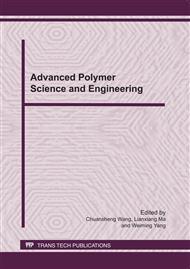p.189
p.194
p.200
p.205
p.211
p.216
p.221
p.228
p.235
Biodegradable Poly(lactic Acid)/TDI-Montmorillonite Nanocomposites: Preparation and Characterization
Abstract:
Activated montmorillonite(MMT) was modified by toluene diisocyanate(TDI) and TDI-montmorillonite(TDI-MMT) was prepared. The characterization of TDI-MMT was carried out by X-ray diffraction(XRD) and fourier transform infrared spectrometry (FT-IR). The results showed that TDI had been inserted to the interlayer of MMT and the interlayer spacing of MMT increased by 0.26nm. With stannous chloride as catalyst, the biodegradable polylactide acid/TDI-montmorillonite(PLA/TDI-MMT) nanocomposites were synthesized through ring-opening polymerization of lactide in the layer of TDI-MMT by in-situ polymerization. The structure and thermal stability of nanocomposites were investigated by XRD, FT-IR and thermogravimetry (TG). Exfoliated nanocomposites were obtained as shown by XRD results. FT-IR spectra confirmed that TDI-MMT participated in the ring-opening polymerization of lactide. TG analysis indicated the decomposition temperature of nanocomposites rose and the thermal stability was improved contrast to the neat PLA. The effect of the content of TDI-MMT on the molecular weight and thermal stability of nanocomposites was studied. With the increase of the proportion of TDI-MMT, the molecular weight of resultant nanocomposites decreased and the decomposition temperature rose at the range of experiment research.
Info:
Periodical:
Pages:
211-215
Citation:
Online since:
March 2011
Authors:
Price:
Сopyright:
© 2011 Trans Tech Publications Ltd. All Rights Reserved
Share:
Citation:


